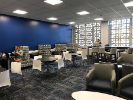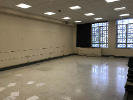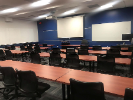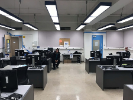News and views for the UB community
Campus News
UB offers new spaces for student learning and instruction
By ROBBY JOHNSON
Published January 8, 2019 This content is archived.
UB faculty, staff and students are enjoying four newly renovated learning spaces on the North and South campuses, thanks to the efforts of UB’s Instructional Facilities Steering Committee (IFSC).
This past summer, 240 Capen Hall, 408 Fronczak Hall and 117 Baldy Hall, all on the North Campus, and 105 Diefendorf Hall on the South Campus were renovated and are now state-of-the-art learning spaces. While 117 Baldy was the only one of the four spaces that had been used previously as a classroom, the space was upgraded and expanded from 24 to 33 seats.
“As UB’s enrollment grows, we prioritize renovations that increase the number of seats and classrooms, and we also try to reduce the risk of losing seats because of deferred maintenance issues,” says Graham Hammill, vice provost for educational affairs and dean of the Graduate School who heads the IFSC. “We also try to focus on areas where faculty and students want to hold classes and try to look for opportunities to integrate innovative pedagogy with classroom design.”
The IFSC is tasked with providing UB with the best instructional spaces possible by creating or renovating classrooms, seminar rooms, instructional and computer labs, learning landscapes or cybraries. The committee also makes recommendations regarding classroom utilization, standards, design and other classroom space issues.
Taking space vacated by other UB units, 240 Capen and 105 Diefendorf offer space for learning in the heart of the North and South campuses. Previously occupied by the Student Response Center, 240 Capen is now a 48-seat classroom; 105 Diefendorf is a welcoming learning landscape for students.
Students may be surprised by the makeover of 408 Fronczak, which was previously a computer lab supported by Computing and Information Technology. Hammill says that space was chosen for renovation mainly because of the great need for more classrooms in that area of the North Campus. The space is now a 54-seat classroom.
“We are always looking to add to the inventory of centrally scheduled classrooms, since the use of these classrooms is exceptionally high,” he says. “CIT decided to no longer support the computer lab in Fronczak 408 due to low usage, so we decided to convert it to a classroom that would be highly used in a desirable area of campus.”
In order to determine which spaces will get a facelift, the IFSC’s various subcommittees assess the areas of highest needs across the university. One of the biggest factors in the assessment is student feedback, Hammill says.

Renovations to 117 Baldy have added nine seats to the classroom.
“There are three subcommittees that work on the selection process: one examines trends in classroom space utilization; another examines the resources need for renovation; and the third sets design standards, given the pedagogical desires of UB faculty and educational needs of UB students,” he explains. “Two students sit on the Pedagogy and Design Subcommittee, as well as a number of faculty. This past fall, that committee hosted workshops on the North and South campuses regarding classroom design. We received significant student feedback, which we will incorporate into future plans for classroom renovation.”

Before renovations, 117 Baldy was a 24-seat classroom.
Planning for the next phase of classroom renovations is reaching the final stages, and the IFSC expects to make an announcement later in the spring.
For now, faculty and students alike can continue to enjoy the new instructional spaces, which Hammill says have been a positive experience for all.
“The response from students and faculty has been extremely positive,” he says. “Everyone sees the value in investing in these critical educational spaces and are excited by the opportunities that the flexible layouts and updated technology provide.”



